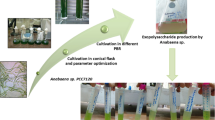Abstract
When Aureobasidium pullulans was grown at a number of agitation rates under batch conditions, exopolysaccharide yields were dramatically reduced at high rates i.e. at least 750 rpm. Investigations with gas blending, which allowed pO2 manipulation and control independently of the agitation rate, showed that this yield reduction was due solely to the high pO2 levels that occurred at these agitation rates. Thus, polysaccharide production at 1000 rpm could be elevated by maintaining the pO2 at a low level during the initial phase of the fermentation. However, both the timing of the pO2 decrease and the level at which it was maintained were crucial for obtaining yields at 1000 rpm, similar to those observed at low agitation rates.
Similar content being viewed by others
Author information
Authors and Affiliations
Additional information
Received: 29 February 1996 / Received revision: 11 July 1996 / Accepted: 15 July 1996
Rights and permissions
About this article
Cite this article
Gibbs, P., Seviour, R. Does the agitation rate and/or oxygen saturation influence exopolysaccharide production by Aureobasidium pullulans in batch culture?. Appl Microbiol Biotechnol 46, 503–510 (1996). https://doi.org/10.1007/s002530050851
Issue Date:
DOI: https://doi.org/10.1007/s002530050851




